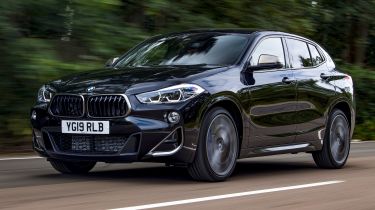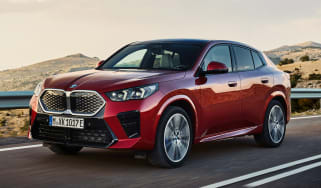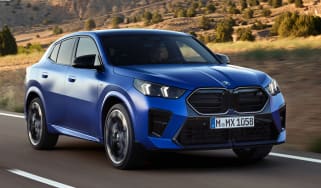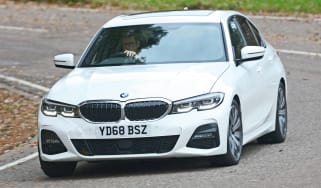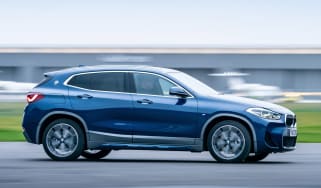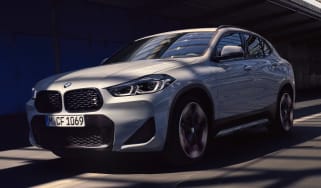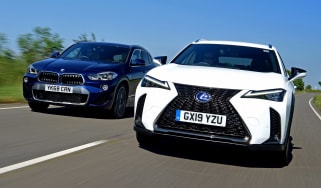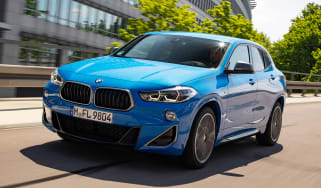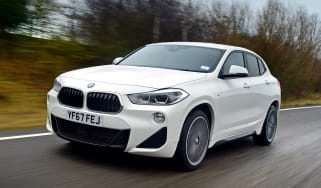BMW X2 review
The low-slung and less than practical BMW X2 is an SUV oddity, but it’s stylish and good to drive

The BMW X2 is an interesting proposition within BMW's extensive line-up. It’s certainly a crossover because it can neither be pigeonholed as an SUV or a jacked up hatchback. The X2 prioritises style over practicality and while it’s fun to drive with its low-slung driving position, it lacks the commanding view that many buyers like in this kind of car.
The cabin delivers the high level of quality and kit that we've come to expect from BMW, although it’s starting to feel dated next to its peers. If space is a priority for you, then you will be better served by the roomier, and less expensive, X1 instead. Within the 2 Series level of BMW cars there’s also the more commodious 2 Series Active Tourer MPV as well.
About the BMW X2
BMW has been a player in the SUV game since the X5 first went on sale in 1999, and the firm has spent the intervening years finding niches to launch new SUV models into.
The X2 arrived in 2018 to fill a small gap between the X1 and X3, and like other ‘even-numbered’ X models it’s designed with a sportier brief than more practical ‘odd numbers’. That said, the X2 isn’t a four-door coupe SUV like its bigger X4 and X6 stablemates, but rather a low slung and swoopy five-door that retains a modicum of estate-car practicality.
Used - available now
It may look sporty – for an SUV crossover at least – but the X2 is pleasant to drive rather than an enthusiast’s delight, being based on the same front- and four-wheel drive UKL2 platform you’ll also find underneath the MINI Countryman.
The BMW X2 is available with both drive options, and cars fitted with the 4x4 system have BMW xDrive badges, while front-drivers are referred to as sDrive models. BMW enthusiasts set great store by the marque’s rear-wheel drive platform as the key to fine handling, but the X2 manages to deliver a decently pleasing set of driving responses in spite of its raised ride height. That’s at least partly due to the fact the X2 rides lower than most SUVs, which means you don’t get such a commanding view of the road when you’re driving it.
Diesel engines are no longer part of the X2 line-up, which leaves the core of the range populated by 18i and 20i-badged 2.0-litre petrol engines. The former is only available as a front-wheel drive model, while the latter gets BMW's xDrive four-wheel drive system.The 18i comes with a six-speed manual gearbox as standard, while the eight-speed auto that's standard on other models, is available as an option. Meanwhile the 20i is offered exclusively with a seven-speed auto.
The plug-in hybrid (PHEV) xDrive25e offers an alternative powertrain option, and uses a 1.5-litre three-cylinder petrol unit plus a electric motor fed by a 10kWh lithium-ion battery for a pure-electric driving range of 32 miles. But sitting at the very top of the X2 range is the 302bhp M35i, with the high-end performance variant also fitting with xDrive four-wheel drive and an eight-speed auto as standard.
Buyers no longer have the option of the SE or M Sport X trim, leaving just the Sport and popular M Sport specifications.
BMW X2 prices and latest deals
Engines, performance and drive
As a sporty looking, coupe-inspired SUV, the BMW X2 needed to deliver a fun driving experience, so BMW spent plenty of time and money developing the X1 based architecture to try and coax out a specific X2 character.
From behind the wheel, the steering feels direct and sharp, and has a weight to it that makes the car feel sporty. Although the xDrive models feel a little heavy when pushed, the X2 still turns-in nicely on twisty tarmac. The steering retains its weighty feel in front-drive sDrive models, and when we pitted a 2.0i sDrive M Sport against the VW T-Roc 2.0 TSI R-Line, the BMW came out on top for sporty feel, rolling less, and offering better levels of grip and agility.
Unsurprisingly for a premium product, the X2 is comfortable and easy to drive on long motorway hauls. However, driver assistance tech for the highway is largely relegated to the options list. On any X2, a lane departure warning system and active cruise control will cost you extra, as part of an options pack.
At speed, the firm ride irons out bumps nicely, though the trade-off is a slightly less-civilised experience when travelling at a lower pace, even when Comfort mode is selected via the optional Electronic Damper Control toggle switch. M Sport models ride on 19-inch wheels too, with the low profile tyres further impeding the ride quality on rougher surfaces, and we found the T-Roc in our back to back test rode a little more comfortably. The big tyres also induce noticeable tyre roar on the motorway, too.
Like with the X1, there’s no full-fat M version of the X2. There is however the X2 M35i, but in our opinion this souped-up, range-topping version doesn't doesn't feel special or fast enough for its sky-high £50,000 list price. In fact, when we pitted the X2 M35i against and Audi SQ2 and Cupra Ateca, the BMW came second behind the Cupra because it wasn't as sharp to drive as the Ateca.
0-62mph acceleration and top speed
Petrol power is covered by the 18i, 20i and range-topping M35i. The entry-level sDrive18i produces 134bhp and manages 0-62mph in 9.6 seconds, while the 176bhp xDrive20i adds four-wheel drive reducing the benchmark sprint time to 7.3 seconds.
The X2 M35i produces 302bhp and 450Nm of torque from its four-cylinder engine. This engine feels plenty potent enough in the M135i hot hatch, but the additional weight of the X2 takes the edge off the performance. At least the four-wheel drive system does help it deliver an impressive 0-62mph time of under five seconds.
The plug-in hybrid X2 xDrive25e combines a relatively small three-cylinder 1.5-litre turbocharged petrol engine with an electric motor and 10kWh battery for a total power output of 217bhp and 385Nm. The standard-fit all-wheel drive also allows the X2 a decent turn of pace, delivering 0-62mph in 6.8 seconds and a top speed of 121mph. When it's running on electric power, the X2 PHEV is as quiet as you’d expect a plug-in hybrid to be.
In the case of the now discontinued diesel versions, the 20d came with 190bhp and 400Nm of torque, resulting in a 7.7-second 0-62mph time. The less powerful 18d offered 148bhp for a 9.7 second 0-62mph time.
MPG, CO2 and running costs
The combined cycle fuel economy figures recorded by the three- and four-cylinder units under the X2’s bonnet are fairly impressive. As ever, you’d struggle to match them in real world conditions, but they are competitive with rivals in the class.
If you opt for a front-wheel drive 18i petrol model, BMW claims you should see returns of between 44.1-45.6mpg if you stick with the standard six-speed manual, or 42.8-44.1mpg if you spring for the dual-clutch automatic. Upgrading to the xDrive20i (available exclusively with a seven-speed automatic gearbox) adds more power and all-wheel drive, and sees a slight fall to around 40mpg.
The finally purely petrol-powered model is the sportier M135i which produces 302bhp from a 2.0-litre four-cylinder engine, with BMW claiming the hot version will return roughly 36mpg.
The plug-in hybrid X2 xDrive25e features a 1.5-litre three-pot petrol engine and a single electric motor fed by a 10kWh lithium-ion battery for a pure-electric driving range of 32 miles, as long as you keep it charged. That takes around five hours from a standard domestic socket, or three-and-a-bit hours if you use a typical 7.4kW home wallbox. It also emits 39-41g/km CO2 figures, depending on trim, making the X2 PHEV the better choice for company car drivers who’ll face reduced Benefit-in-Kind tax.
Although they’re now removed from the X2 price list, those seeking frugality should look at used examples of the front-wheel-drive 18d diesels which had a WLTP combined economy figure of well over 50mpg. Add xDrive all-wheel drive to the 18d and the figure drops to 50.4mpg or 49.6mpg for models fitted with an automatic gearbox. A 20d version was also available, although economy drops to 48.7mpg with the more powerful 20d.
Insurance groups
Groups for the X2 range from 22 to 40 (out of 50), depending on which trim and engine combination you go for. Unsurprisingly, the 302bhp M135i will be the most expensive version to insure in group 40, while the X2 PHEV sits in either group 30 or 31.
Check your tax status and renewal date in seconds. Check your VED car tax now...
Depreciation
Depending on specification, the X2 should hold on to between 45 and 50 per cent of its value after three years and 36,000 miles of ownership, with the plug-in xDrive25e in Sport trim performing the best of the bunch.
To get an accurate valuation on a specific model check out our free car valuation tool...
Interior, design and technology
The X2 fills a gap in BMW’s line-up, although some would argue that it's a gap that doesn't really exist. BMW uses its 'Sports Activity Vehicle' branding to give it a bit more of an active lifestyle appeal. But unlike its other SAVs, the X4 and X6, the X2 doesn't get a coupe profile, instead opting for a more swooping hatchback-style line.
It's a look that was previewed by the Concept X2 design study that did the rounds of the motor shows ahead of the X2's launch. And that concept's rakish hatchback rear end, low stance, angular, sporty bumpers and rugged SUV cladding are all carried over to the production model. However, standing next to the car reveals that it doesn’t stand very tall – its roof is no higher than a family hatchback’s.
Swept-back lights, a rising window line (incorporating BMW’s signature Hofmeister kink), ultra-slim hatchback glass and even the BMW badge inset into the C-pillars, are all design cues that have been transferred over from the Concept X2 – first seen at the 2016 Paris Motor Show, unfortunately the final production model is slightly muted in comparison.
Short overhangs help give the X2 a sportier look than the X1, but the two models actually share the same wheelbase. The X2 occupies a similar footprint to most family hatchbacks and the fact it’s only 2mm taller than the current Volkswagen Golf highlights the X2’s sleek profile.
While the car’s exterior design is quite different to every other car in the X line-up, the interior is much more straightforward. It’s lifted almost wholesale from the second-generation X1, so it’s immediately familiar in both layout and quality, with a neat centre panel, top quality materials and a digitalised instrument panel. It should be noted that BMW’s digital instruments are quite unlike Audi’s Virtual Cockpit system, however – they are purely computerised versions of the traditional binnacles. The new X1 features BMW’s latest iDrive infotainment set-up and dual displays, making the X2’s older system feel dated in some areas.
Sat-nav, stereo and infotainment
All X2 models get a 8.8-inch infotainment system with sat-nav, which can also be operated through a trademark BMW rotary iDrive dial. As such, the set-up offers the best of both worlds, with the rotor button making the infotainment easy to use on the move.
As expected of a premium brand, the interfaces are simple and clear to navigate, slick to respond and quick to load. Apple CarPlay is now standard across the range, but Android Auto is not available at all. A head-up display is offered as part of the Technology Pack 2, sitting just below the driver’s line of sight and supplementing the basic digital dials, while BMW also offer an upgraded Harman Kardon stereo for an extra £660.
Some models can be had with a sunroof – a £1,100 optional extra. There’s also a Comfort Pack which includes keyless entry, electric front seats with memory function and a heated steering wheel. The Technology Pack 1 adds a adaptive LED headlights, wireless charging pad and reversing camera, while Technology Pack 2 includes the aforementioned head-up display and BMW’s ‘Navigation Plus’ sat-nav on a large 10.25-inch central screen.
Practicality, comfort and boot space
Given the crossover pretention of the X2, the low slung driving position is a bit of a surprise at first. Rather than offering the commanding view of the road ahead you'd expect of an SUV, it's almost like you're getting behind the wheel of BMW's 1 Series hatchback. It's an unusual sensation, but emphasises the X2's sportiness.
The low roof also compromises cabin space when compared to the old BMW X1. The small windows and thick C-pillars make the rear of the X2 feel claustrophobic, while rearward visibility isn't great, but BMW has sensibly added standard-fit rear parking sensors.
The various storage cubbies around the cabin are lifted straight from the second-generation BMW X1, with a centre armrest cubby, a decent glovebox and door bins and a useful tray for storage ahead of the gear lever.
Dimensions and size
The BMW X2 is 4,360mm long, 1,824mm long and 1,526mm high. In comparison, the BMW X1 is slightly longer, narrower and taller, but has the same wheelbase.
Leg room, head room and passenger space
Leg and shoulder room is comparable to even the newest X1, but the X2's rakish roof line does limit rear headroom a little. The small windows and high door line also make it feel a little claustrophobic in the back.
Most crossovers and small SUVs trade on their ability to offer a commanding view of the road ahead, but the X2 isn't your typical SUV. The low-set driving position is very sporty, and emphasises its character as a sharp handling car. Still it's easy to get a comfortable driving position.
Boot space
The BMW X2's 470-litre boot is equivalent to most family hatchback, but it's 60 litres less than you get with an Audi Q3 and 30 litres down on the new X1’s luggage area.Fold the back seats flat, and you get 1,355 litres of space, while there's room under the boot floor to add an optional space-saver spare wheel.
The X2 PHEV does lose a bit of luggage volume due to the battery, reducing the boot size by 60 litres to 410 litres – 25 litres larger than the Mercedes GLA PHEV’s boots. A powered tailgate is fitted as standard on all X2s, while there's additional storage nets in the rear cabin and boot.
Reliability and safety
Because it shares so much of its structure and safety equipment with the BMW X1, the X2 has the same Euro NCAP rating of five stars. Euro NCAP did partially test the X2 to ensure that its safety credentials stack up with the X1, which it does, so it gets the same 90 per cent score for adult occupant protection, 87 per cent for child occupants, 74 per cent for pedestrian safety and 77 per cent for its safety assist systems
That latter score is courtesy of the raft of safety kit that BMW gives the X2, with all models featuring the Active Guard system that monitors potential hazards and will autonomously apply the brakes in certain instances where an emergency stop situation is required.
The £1,265 Driving Assistance Plus pack builds on this, with semi-autonomous driving functions enabled by camera-based cruise control technology. This adds acceleration, braking and steering support in stop-start traffic or in a single lane on motorways.
BMW as a brand finished 16th out of 29 manufacturers in our 2022 Driver Power survey, up from 21th spot in 2021. As the X2 uses the same running gear as the previous X1, and the outgoing MINI Countryman, the tech on board is well proven, although BMW's Driver Power rankings mean the X2 ownership experience may not be as good as it is for some rival models.
Warranty
The BMW X2 comes with a three-year, unlimited mileage warranty – the same as all new BMWs – plus you get a three-year subscription to the BMW Emergency breakdown service. Various warranty extension plans are available, too.
Servicing
BMW offers its Pay Monthly service plan which covers two services and allows you to spread the cost of scheduled maintenance.
BMW X2 Alternatives
Rivals include the Volvo XC40 and Jaguar E-Pace, top-spec versions of the Volkswagen T-Roc and MINI Countryman, as well as lower-spec versions of the Range Rover Evoque, plus the ageing Audi Q3 and more hatchback-like Mercedes GLA. However, there are other rivals in-house, because the BMW X1 offers a similar drive but with a more practical interior and newer tech, while the 1 Series offers lower running costs and sporty handling in a cheaper, more car-like package.

